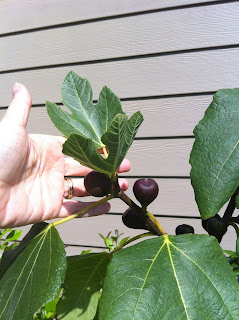 |
| Early April lettuce and spinach |
Saturday, March 28, 2020
April showers bring May flowers, fruits, herbs and vegetables. Now is the perfect time to get serious on getting your spring garden planted and sowed! I have seeds and plants going indoors and outdoors.
Crops to plant in April
Early April is a perfect time to plant cold season crops like Brussels sprouts, fava beans, beets, broccoli, cabbage, carrots, cauliflower, celery, collards, kale, lettuce, mustard, onions, parsley, parsnips, peas, potatoes, radishes, shallots, spinach, strawberries, Swiss chard and turnips. Outdoor transplant calendar
See this post for what to plant in April as well as links on how to grow each veggie. What to plant in the April edible garden
I am planting sprouting broccoli this spring. I did not plant it last year due to pest issues the year before. I'll treat with BT, which is an organic treatment to keep the caterpillars from munching down the leaves. Sprouting broccoli is one of my favorite edibles. The leaves taste like broccoli and are sweet all through spring, summer and fall. You also get little broccoli florets to eat on and off through the season. It is also very cold tolerant and can survive winters here. Sprouting broccoli- a year round fav
We can still get frosts in April so you want to hold off on planting warm season crops outdoors like tomatoes, eggplant, peppers and squash until May unless you cover them or bring them indoors if frost does visit your garden. Extend the season with protection for plants
I transplanted lettuce and spinach plants outdoors. I have already sown lettuce, spinach, kale, potatoes, radishes, beets and chervil seed in pots outdoors. I started seeds indoors for Chinese cabbage, cilantro, Dragon's Tail radish for late spring, early summer harvests. Overwintered celery, parsley, carrots, chives, onions, cultivated dandelion, sorrel, tarragon, sage, thyme, arugula, kale, leeks and corn salad are up and ready to eat.
To keep yourself in lettuce all season, do succession planting of new seeds or plants every 2-3 weeks. Just plant the number you would normally eat in a 2-3 week period. This will keep salads on the table continuously. Want continuous harvests? Succession planting!
To get a jump on summer harvests, I started a variety of edibles indoors on the kitchen counter in both my Aerogarden and peat pods. For the large seedlings like cucumber, squash, and watermelon, I start these in peat pods. The rest I start in the Aerogarden. I have had great success in the Aerogarden in germination rates. It is really close to 100% across all types of seeds.
Fertilize
When you plant, make sure to fertilize and add mycorrhizae in each planting hole. Mycorrhizae are beneficial microbes that help your plant roots absorb nutrients from the soil. Once mycorrhizae is added in that spot, it will live on in the soil so it does not have to be reapplied next year in that spot.
If you are re-using pots from last year, here is a link to get your potting soil ready to nourish your new plants: Re-energize your potting soil! It is important to get your potting soil ready to support this season's growth and veggie production. Be sure when you fertilize to mix it into the soil or apply before you put down a protective and organic layer of mulch. This keeps the nitrogen from oxidizing and escaping into the air instead of staying in the ground to nourish your plant. This year, I did all my pots. I added 1 part compost to 2 parts potting soil, Azomite for minerals, and Espoma fertilizer. My plants should have everything they need for a strong start to the growing season.
Frost date importance
The last frost date in our area is around April 15th. This is important to know if you are planting seeds. Frost date look up The seed packet tells you when to plant in relation to your last frost date. You will get the best results following the packet instructions. Planting early is not always a good strategy as different seeds need different soil temperatures before they will germinate. Plant too early and they can rot before they have a chance to sprout. When to plant your veggies
Pots will warm up quicker, but will also chill down faster. You can put your pots in a sheltered, sunny spot to get a jump on spring. Putting your pots on the south side of the house will provide the maximum warmth. I lover planting greens in a large self watering pot that I can keep on the patio, making it handy for picking a fresh salad for dinner, and to move to a cooler spot in the hot days of summer.
When growing veggies in containers, they will require more watering and more liquid fertilizer than if they were in the ground. In the summer, you may have to water some water lovers every day. For more on growing in pots. Decorative container gardening for edibles
With the self-watering pots, your watering duties will be greatly reduced.
With the self-watering pots, your watering duties will be greatly reduced.
Lettuce, greens, and herbs do fabulous this month. It is the time to indulge in daily salads. and smoothies. Cool temperatures and lots of moisture produce the sweetest greens of the season.
This year, you may have more time or just want to be sure you can get fresh veggies. Here is a garden that meets that need, even if you only have a small space, like a flower bed. Small space survival edible garden












